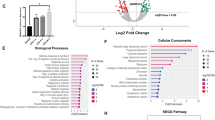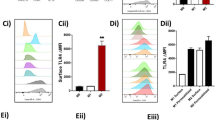Abstract
Bacterial lipopolysaccharide (LPS), the major surface component of gram-negative bacteria, exerts a profound effect on the immune system by enhancing the release of proteins and arachidonic acid metabolites from macrophages (for review see ref. 1). The molecular mechanism(s) by which LPS induces these various secretory responses is unknown. We previously reported that LPS promotes the myristoylation of several macrophage proteins including one with a relative molecular mass (Mr) of 68K2. We have now found that by several criteria the 68K myristoylated protein is similar or identical to the 80/87K protein, a major specific substrate for protein kinase C (PKC) found in brain and fibroblasts3–6 (for review see refs 7,8). We have also found that the myristoylated PKC substrate is quantitatively associated with the membrane fraction. Myristoylation of the PKC substrate may target it to the membrane and constitute a transduction pathway for stimulus-response coupling.
This is a preview of subscription content, access via your institution
Access options
Subscribe to this journal
Receive 51 print issues and online access
$199.00 per year
only $3.90 per issue
Buy this article
- Purchase on Springer Link
- Instant access to full article PDF
Prices may be subject to local taxes which are calculated during checkout
Similar content being viewed by others
References
Morrison, D. C. & Ulevitch, R. J. Am. J. Path. 93, 527–617 (1978).
Aderem, A. A., Keum, M. M., Pure, E. & Cohn, Z. A. Proc. natn. Acad. Sci. U.S.A. 83, 5817–5821 (1986).
Wu, W. S., Walaas, S. I., Nairn, A. C. & Greengard, P. Proc. natn. Acad. Sci. U.S.A. 79, 5249–5253 (1982).
Albert, K. A., Walaas, S. I., Wang, J. K.-T. & Greengard, P. Proc. natn. Acad. Sci. U.S.A. 83, 2822–2826 (1986).
Blackshear, P. J., Wen, L., Glynn, B. P. & Witters, L. A. J. bio. Chem. 261, 1459–1469 (1986).
Rozengurt, E., Rodriguez-Pena, M. & Smith, K. A. Proc. natn. Acad. Sci. U.S.A. 80, 7244–7248 (1983).
Neidel, J. E. & Blackshear, P. J. in Phosphoinositides and receptor mechanisms (ed. Putney, J. W.) Ch. 3, 47–88 (Alan R. Liss, New York, 1986).
Woodgett, J. R., Hunter, T. & Gould, K. L. in Cell Membranes: Methods and Reviews, 3rd edn (eds Elson, E. L., Frazier, W. A. & Glazer, L.) (Ch. 6, 215–340, Plenum, New York, 1987).
Albert, K. A., Nairn, A. C. & Greengard, P. Proc. natn. Acad. Sci. U.S.A. 84, 7046–7050 (1987).
Nishjzuka, Y. Science 233, 305–312 (1986).
Pellman, D., Garber, E. A., Cross, F. R. & Hanafusa, H. Nature 314, 374–377 (1985).
Cross, F. R., Garber, E. A., Pellman, D. & Hanafusa, H. Molec. cell Biol. 4, 1834–1842 (1984).
Kamps, M. P., Buss, J. E. & Sefton, B. M. Proc. natn. Acad. Sci. U.S.A. 82, 4625–4628 (1985).
Rein, A., McClure, M. R., Rice, N. R., Luftig, R. B. & Schultz, A. M. Proc. natn. Acad. Sci. U.S.A. 83, 7246–7250 (1986).
Aderem, A. A., Cohen, D. S., Wright, S. D. & Cohn, Z. A. J. Exp. Med. 164, 165–179 (1986).
Wang, J.K.-T., Walaas, S. I. & Greengard, P. J. Neurosci. 8, 281–288 (1988).
Nichols, R. A., Haycock, J. W., Wang, J.-K.-T. & Greengard, P. J. Neurochem. 48, 615–621 (1987).
Blackshear, P. J., Witters, L. A., Girard, P. R., Kuo, J. F. & Quamo, S. N. J. bio. Chem. 260, 13304–13315 (1985).
Rodriguez-Pena, A. & Rozengurt, E. EMBO J. 4, 71–76 (1985).
Tsuda, T., Kaibuchi, K., Kawahara, Y., Fukuzaki, H. & Takai, Y. FEBS Lett. 191, 205–210 (1985).
Isacke, C. M., Meisenhelder, J., Brown, K. D., Gould, K. L., Gould, S. J. & Hunter, T. EMBO J. 5, 2889–2898 (1986).
Sato, C., Nishizawa, K., Nakayama, T. & Kobayashi, T. J. Cell Biol. 100, 748–753 (1985).
Coughlin, S. R., Lee, W. M. F., Williams, P. W., Giels, G. M. & Williams, L. T. Cell 43, 243–251 (1985).
Mahadevan, L. C., Aitken, A., Heath, J. & Foulkes, J. G. Embo J. 6, 921–926 (1987).
Huttner, W. B. & Greengard, P. Proc. natn. Acad. Sci. U.S.A. 76, 5402–5406 (1979).
Olson, E. N., Towler, D. A. & Glaser, L. J. bio. Chem. 260, 3784–3790 (1985).
Sefton, B. M. & Buss, J. E. J. Cell Biol. 104, 1449–1453 (1987).
Author information
Authors and Affiliations
Rights and permissions
About this article
Cite this article
Aderem, A., Albert, K., Keum, M. et al. Stimulus-dependent myristoylation of a major substrate for protein kinase C. Nature 332, 362–364 (1988). https://doi.org/10.1038/332362a0
Received:
Accepted:
Issue Date:
DOI: https://doi.org/10.1038/332362a0
This article is cited by
-
Pathophysiological roles of myristoylated alanine-rich C-kinase substrate (MARCKS) in hematological malignancies
Biomarker Research (2021)
-
Myristic Acid Increases Dihydroceramide Δ4‐Desaturase 1 (DES1) Activity in Cultured Rat Hepatocytes
Lipids (2012)
-
Protein N-myristoyltransferase 1
AfCS-Nature Molecule Pages (2004)
-
Evidence for regulation of interaction of endogenous protein kinase C (PKC) substrates with plasma membrane by PKC down-regulation in K562 cells
Archives of Pharmacal Research (1995)
-
Mammalian myristoyl CoA: protein N-myristoyltransferase
Molecular and Cellular Biochemistry (1995)
Comments
By submitting a comment you agree to abide by our Terms and Community Guidelines. If you find something abusive or that does not comply with our terms or guidelines please flag it as inappropriate.



